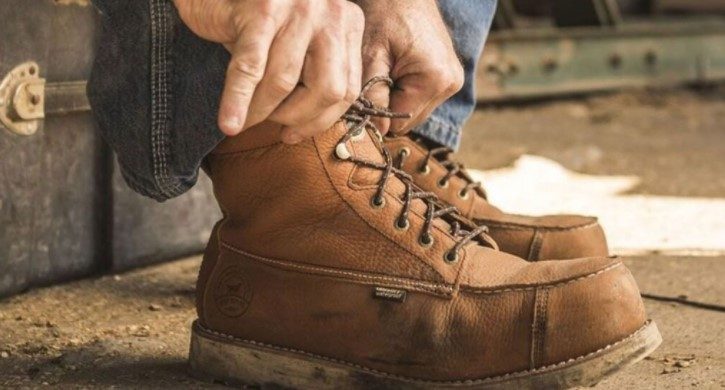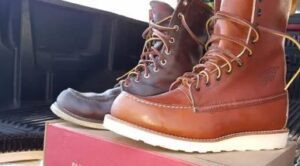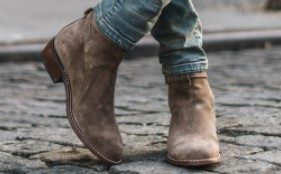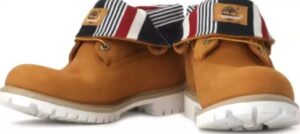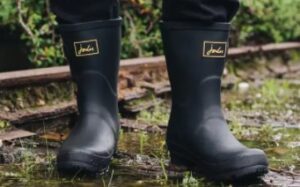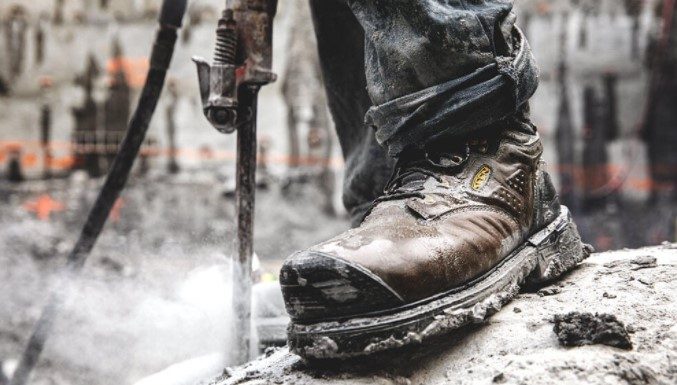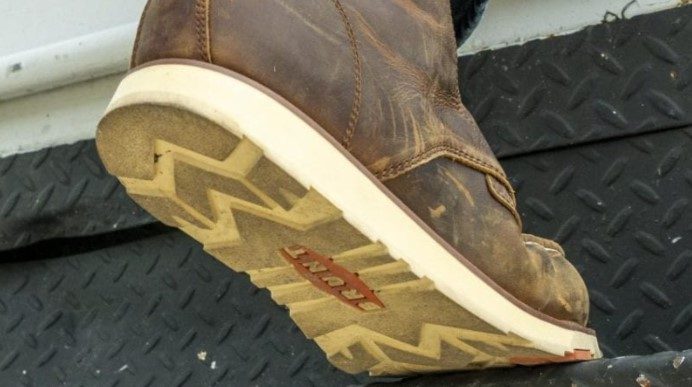Work boots are designed differently from regular shoes and boots. It’s a requirement by The Department of Labor & OSHA (Occupational Safety and Health Administration) for employees to wear safety work boots at hazardous workplaces.
However, the biggest concern for most people is the weight of work boots. This is important, especially when working for long hours.
But wait! How much do work boots weigh?
On average, most work boots weigh around 2-3 pounds. That’s about 1-1.5 pounds per boot. Boots with a steel toe cap weigh an average of 4-4.5 pounds. Overall, you can expect minimal weight differences depending on the exact boot components and materials.
In general, work boots are durable and rugged, hence the extra weight. The additional safety features further increase the boot weight. However, most people prefer lightweight breathable work boots that won’t add any excess weight to the foot.
In this post, I’ll provide a detailed answer on how much work boots should weigh, features that affect the weight and how the weight can affect you.
Plus, I’ll help you decide between lightweight and heavy work boots. I’ll also share 10 popular work boots and their exact weight.
Let’s dive in.
How Much Does The Average Pair Of Boots Weigh?
As indicated earlier, the average pair of boots weigh between 2-4.5 pounds.
The boot materials and safety feature immensely affect the exact boot weight.
Let’s have a look at different boot materials and how they weigh.
1) Leather Boots Weight:
You probably have a leather boot since they are the most durable and popular. Leather is processed dead animal skin. The tannery process prevents decay and rotting, which is referred to as putrefaction.
Leather boots are among the heaviest, weighing up to 4 pounds. The extra weight can be attributed to the leather material. Leather boots are the best but come at an additional cost.
2) Suede Boots Weight:
Suede boots are also excellent choices and are much lighter than leather boots. However, it is essential to note that suede is still a form of leather.
Suede leather undergoes a different tanning process and is not as durable as leather pure leather. They weigh an average of 1.5-2 pounds. They are a great alternative to leather boots and cost less.
3) Fabric Boots Weight:
Fabric boots are made of synthetic materials which are incredibly lightweight. Fabric boots were designed to be an alternative to persons that didn’t want heavy boots.
Nowadays, there are a lot of inventions on fabric boots. Most of these boots are used for walking, hiking, hunting and much more due to their lightweight design.
An average fabric boot weighs up to 1kg.
The boots strike a good balance between durability and lightweight. Furthermore, fabric boots are not just lightweight and durable but also comfortable.
4) Plastic Boots Weight:
Plastic boots are the lightest in the market and come at an affordable price. They are not ideal work boots, with most people using them as rain boots. On average, plastic boots weigh less than a pound.
The boots are durable but not very comfortable. Plastic doesn’t stretch, and there is little room to break in.
How Much Do Steel Toe Boots Weigh?
Steel toe boots are among the heaviest work boots. The extra weight can be attributed to the steel cap on the toe.
On average, steel toe boots weigh 3.5- 4.5 pounds. This translates to 1kg to 1.8kgs.
Steel toe boots are a favorite for workers in different fields. They have been in use for decades in the construction industry, brick-laying, plumbing, mining, welding, etc.
The built-in steel toe cap offers more protection compared to composite and alloy toe caps.
Here is a table illustrating different boot styles and their estimated weights:
| Boot Style | Estimated Weight |
| Hiking boots | 2-3 pounds |
| Skiing boots | 2kg |
| Snowboarding boots | 6-8 pounds |
| Hunting boots | 4 pounds |
| Army boots | 1.2-2.4 pounds |
| Cowboy boots | 3-4 pounds |
What Features Make Work Boots Heavy?
Now that you know work boots are heavier let’s dive in and see features that make them heavier apart from the construction materials.
The upper
The upper material on work boots is a lot thicker than what you find in regular boots. Let’s take, for example, leather work boots and regular leather boots. The leather on work boots is thicker to offer more protection.
This makes work boots heavier. Even for fabric work boots, the fabric material is thicker than in regular boots. Thicker upper materials protect sharp objects at job sites.
Outsoles
The outsoles also add significant boot weight. The weight of boots can vary depending on the type of outsole. Here are common boot outsoles and how they affect weight:
- Leather outsoles: Leather outsoles are extremely durable but also heavy. They add significant weight to the boot. However, boots with leather outsoles are pricey.
- Rubber Outsoles: Rubber outsoles are cheaper to leather but weigh more. They are thicker and hard-wearing compared to leather.
- Commando Outsoles: These are the heaviest outsoles on the list. The extra weight is due to the rugged design, thick lugs and weather-resistance construction. The boots are not ideal for work but suitable for trekking and hiking rough terrains.
- Ridgeway outsoles: These are rubber outsoles with protruding thick lugs. While they are lighter than Commando outsoles, they are still heavy.
- Cork Nitrile outsoles: Cork Nitrile soles comprise cork and rubber mixtures. They are extremely lightweight since they lack lugs and traction.
- Wedge outsoles: Wedge outsoles are extremely lightweight with sponge characteristics. They are not ideal for work boots as sharp items can prick through.
- Crepe Outsoles: Lastly, we have crepe outsoles with sponge characteristics and unique patterns. They are used for desert boots.
Shank
The shank material underneath the midsole also affects the boot’s weight. Steel shanks weigh more than alloy and fiberglass shanks. Common toe shank materials include:
- Steel
- Leather
- Fiberglass
- Wood
- Composite
Padding & Insulation
The extra padding above the insole adds to the boot’s weight. In addition, shoes with extra insulation against cold add to the boot’s weight.
Toe Cap Protection
Just like the shanks, the materials used in the toe cap affect the boot’s weight. Steel toe caps weigh more than leather and composite toe caps.
In addition, toe caps come in different sizes and shapes. Boots with larger toe caps are generally heavier. Common toe cap materials include:
- Steel
- Aluminum
- Composite
- Leather
How The Weight Of The Boot Can Affect You?
In a sense, the weight of the boot affects you depending on your situation. For example, construction workers working on uneven ground are affected more than factory workers.
But, it makes sense that heavier boots will get you exhausted faster than lightweight boots.
Here are several ways the weight of the boots can affect you:
- Lifting heavy boots for long periods affects the leg muscle tendons
- Knee and joint pains due to the exerted pressure of the boot’s weight
- Lower back pain due to feet stress
- Corns on the feet due to stiff and heavy boots
- Feeling of restlessness due to feet fatigue
I suggest you get at least two pairs of work boots. These can be heavier and lighter boots for different jobs.
10 Popular Work Boots And How Much They Weigh?
Here are some 10 popular work boots and their weights. Take a look and see what suits your needs.
| Popular Boots | Weight |
| Caterpillar Men’s Second Shift Steel Toe Work Boot | 5.2 pounds |
| Wolverine Men’s Floorhand 6 Inch Waterproof Soft Toe Work Shoe | 4.9 pounds |
| EVER Boots Tank Men’s Work Boot | 4.4 pounds |
| Skechers Men’s Burgin-Tarlac Industrial Boot | 2.06 pounds |
| Timberland PRO Work Summit Men’s Composite Toe | 4.4 pounds |
| Danner Men’s Bull Run 6” Work Boot | 1.81 pounds |
| Timberland Pro Men’s Work Boot | 3.16 pounds |
| Wolverine Men’s Overpass 6″ Composite Toe Waterproof Work Boot | 1.75 pounds |
| Timberland PRO Men’s Boondock | 4.4 pounds |
| Carhartt Men’s 6-Inch Waterproof Wedge Soft Toe Work Boot | 4.5 pounds |
Lightweight Vs Heavy Work Boots: Which Is Best For You?
The choice between a lightweight and heavy work boot depends on the job you’re doing.
For example, electricians can choose lightweight work boots while mechanics and construction workers go for heavy boots.
If you’re working outdoors, consider waterproof work boots.
Overall, there is no single best work boot. You get to choose a work boot based on the job and working conditions.
Conclusion
Well, that’s it from me! I hope you can now decide what’s the best work boot for you. Now you know how much work boots weigh and the popular work boots right now.
Make sure you consider solid and rugged work boots that offer the best protection. However, cut down on the heaviest boots as they cause fatigue fast.
Have a great workday ahead in your new work boots!

